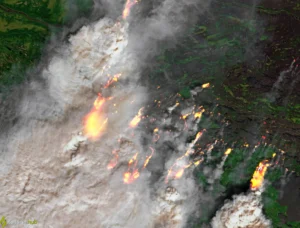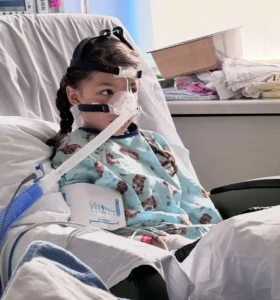
Massive fires in Québec, Canada, in 2023, when wildfire smoke blanketed the region. (Contains modified Copernicus Sentinel data 2023, CC BY 2.0, via Wikimedia Commons)
For 9-year-old Aliah Reyes of Chicopee, it’s not always possible to play like other kids. Because of her asthma, she has to be careful running, with the weather, dust, and strong smells. “She just wants to breathe like everyone else without thinking about it,” her mom, Priscilla Rivera, explained. But she often has to miss school days because of hospital stays — a reality that has frustrated Aliah and has drained her mother emotionally and financially.
“Watching your child struggle to breathe is terrifying. It means sleepless nights, constant monitoring, ER visits at 2 a.m., and days spent in the ICU,” Rivera said. Her daughter has been in intensive care some 23 times, and the costs keep rising: hospital bills, copays, specialist visits and travel to Boston Children’s Hospital. “No child should have to live like this.”
Recently, a new danger has threatened Aliah’s ability to breathe: wildfire smoke.
It’s a sight that has become increasingly familiar in recent years. A disconcerting haze fills the air as smoke drifts over the Connecticut River Valley, sometimes from wildfires burning hundreds or even thousands of miles away. Scientists say it is already harming the health of local residents — something Rivera and her daughter know firsthand. On those days, her daughter’s coughing and wheezing gets much worse and she needs extra nebulizer treatments on top of all her other medications.
“We try to keep her inside, but even then it’s hard — I run two dehumidifiers and three air purifiers just to keep the air somewhat clean,” Rivera said. “It makes me anxious because any bad air day can send us to the ER. It impacts our whole family. We feel trapped inside, constantly worried about her health.”

Aliah Reyes sits on a hospital bed. (Photo courtesy of Priscilla Rivera)
As climate change heats the planet and fuels extreme swings between wet and dry weather, scientists say that wildfires are becoming more common. So, too, are the health impacts of wildfire smoke. New England is already referred to as the “tailpipe of the nation” because pollution from elsewhere in the country blows into the region and settles here. This year, the American Lung Association found that nearly half of Americans suffer from unhealthy air pollution and that wildfires are a “major driving factor” in that trend.
Sometimes the impact of distant wildfires in western Mass is obvious, like when smog from Quebec’s wildfires blanketed the northeast in 2023, painting the sky orange and making headlines nationwide. Other times, however, it can be less apparent. In May, for example, wildfires in British Columbia, Canada, sent plumes of smoke over the region from some 3,000 miles away, causing air quality to become unhealthy at times for “sensitive groups” like children, the elderly, and those with heart or lung disease. But because the smoke wasn’t as thick, many might not have noticed.
Exposure to particulate matter from wildfire smoke poses a wide range of health threats. In addition to damaging the respiratory system, studies have shown that it can also increase the risk of adverse birth outcomes, damage the cardiovascular system, and lead to increased mortality.
The harm can also extend to people’s nervous systems. A study last year, for example, found a hazardous link between wildfire smoke and increased risk of dementia. And the year before, University of Massachusetts Amherst economist Jamie Mullins co-authored a study that found that drifting wildfire smoke led to an increased risk of suicide in rural areas.
“All these systems are connected to one another,” said Jared Schwartzer, a behavioral neuroscientist at Mount Holyoke College who studies how environmental factors during pregnancy, like air pollution, can impact children’s brain and behavioral health. Fine particulate matter can cause inflammation throughout the body, he said, which can also impact their health and that of their unborn child.
The burden of that pollution, local scientists and public health advocates say, has fallen disproportionately on communities of color, those who live near highways or industrial areas, workers who labor outdoors, and those with preexisting health conditions like asthma — groups with significant overlap due to the legacies of structural racism in the United States.
“If you look at many areas within Holyoke and Springfield proximate to [Interstate] 91 and the industrial activity, this is just another hit to them in terms of what their bodies are dealing with,” said Krystal Pollitt, an associate professor of epidemiology at Yale University.
Rivera said that her community’s kids are growing up breathing in pollution “just because we’re a Black and Latino community living near highways and factories.”
“If this was a wealthy neighborhood, they wouldn’t allow it,” she said. “It feels like our health doesn’t matter, and that’s painful to accept.”
Pollitt works as a researcher with the Healthy Air Network, which has been tracking pollution in western Massachusetts in order to better inform residents about the air they’re breathing. A coalition of organizations led by the nonprofit Public Health Institute of Western Massachusetts, the Healthy Air Network emerged in 2020 as a way to address the high rates of asthma in Springfield and surrounding communities.
Pollitt explained that particulate matter isn’t the only dangerous pollutant from wildfire smoke. Because wildfires often also burn through plastics, building and furnishing materials, and more, there is a complex mixture of many dangerous compounds.
Warmer temperatures are also increasing ozone in the atmosphere — a pollutant that scientists describe as causing damage to the lungs similar to a sunburn.
Sarita Hudson is the senior director of strategy and development at the Public Health Institute of Western Massachusetts. She explained that in 2023, the state found that Springfield had the worst particulate matter pollution in the entire state. Last year, the Asthma and Allergy Foundation of America yet again ranked the city among the country’s “asthma capitals.” Air quality in the region had improved in recent years, she said, but climate change-fueled wildfires in Canada have been a setback to that progress.
Air quality can vary vastly depending on where somebody is, the time of day, or the season. For that reason, the Healthy Air Network has installed air sensors across the region that measure particulate matter every two minutes. The coalition then posts that information on its website, providing a map that western Mass residents can use to make real-time decisions to protect their health by, for example, reducing their outdoor activity on days with bad air quality.

A chart from the Healthy Air Network shows how levels of fine particulate matter vary from season to season.
However, that kind of work and other measures to improve indoor and outdoor air quality in the region have come under attack from the Trump administration.
Already this year, President Donald Trump and his Republican allies have cut millions of dollars in federal funding for everything from wildfire preparedness training to specific programs meant to address asthma rates in Hampden County and improve air quality across the region. That includes a $20 million Environmental Protection Agency grant to Springfield that, among other measures, would have funded the installation of more air-monitoring sensors. The Trump administration is also slashing staff at the EPA, which monitors air quality nationwide, making wildfire smoke even more dangerous.
The Hitchcock Center in Amherst, which is also part of the Healthy Air Network, had a $500,000 grant terminated that included air quality monitoring work. Billy Spitzer, the center’s executive director, described the grant termination as “illegal, unprecedented, unethical, and a terrible loss.”
“Air pollution doesn’t care if you vote Democrat or Republican, these are widespread health issues that have a big economic costs,” he said. “These are explicitly grants to try to address environmental inequities and injustice. This administration has said they do not support those kinds of initiatives.”
Spitzer said that climate change and the wildfires it is fueling have made it clear that those in western Massachusetts, for example, can’t ignore what’s happening on the other side of Canada just because it’s not nearby.
“I think the wildfires really brought it home for people that there’s one atmosphere that we share,” he said. “It really makes you think a little differently about what you’re doing … We actually all breathe that air sooner or later and I think the wind patterns have really driven that home.”
For Aliah Reyes and other kids suffering from asthma like her, the consequences are already here.
“The most heartbreaking thing I’ve seen is other single mothers who have to leave their sick kids with nurses just so they can go to work and provide for their families,” said Rivera, her mother. “I’ve seen kids alone at night because they’re under [Department of Children & Families] care with no one by their side at night. It’s insane and heartbreaking.”
Rivera said she just wants political leaders to finally take air quality seriously.
“Families like mine also need better access to affordable medications, specialists, and preventive care without having to constantly fight insurance,” she said. “But honestly, we shouldn’t just keep treating asthma. We need to address what’s causing it. Our kids deserve clean air to breathe, just like any other child. It’s their responsibility to make sure that happens.”




